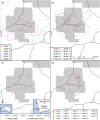Space use and habitat selection of an invasive mesopredator and sympatric, native apex predator
- PMID: 32391154
- PMCID: PMC7197163
- DOI: 10.1186/s40462-020-00203-z
Space use and habitat selection of an invasive mesopredator and sympatric, native apex predator
Abstract
Background: Where mesopredators co-exist with dominant apex predators, an understanding of the factors that influence their habitat and space use can provide insights that help guide wildlife conservation and pest management actions. A predator's habitat use is defined by its home range, which is influenced by its selection or avoidance of habitat features and intra- and inter-specific interactions within the landscape. These are driven by both innate and learned behaviour, operating at different spatial scales. We examined the seasonal home ranges and habitat selection of actively-managed populations of a native apex predator (dingo Canis dingo) and invasive mesopredator (feral cat Felis catus) in semi-arid Western Australia to better understanding their sympatric landscape use, potential interactions, and to help guide their management.
Methods: We used kernel density estimates to characterise the seasonal space use of dingoes and feral cats, investigate inter- and intra-species variation in their home range extent and composition, and examine second-order habitat selection for each predator. Further, we used discrete choice modelling and step selection functions to examine the difference in third-order habitat selection across several habitat features.
Results: The seasonal home ranges of dingoes were on average 19.5 times larger than feral cats. Feral cat seasonal home ranges typically included a larger proportion of grasslands than expected relative to availability in the study site, indicating second-order habitat selection for grasslands. In their fine-scale movements (third-order habitat selection), both predators selected for roads, hydrological features (seasonal intermittent streams, seasonal lakes and wetlands), and high vegetation cover. Dingoes also selected strongly for open woodlands, whereas feral cats used open woodlands and grasslands in proportion to availability.
Management recommendations: Based on these results, and in order to avoid unintended negative ecological consequences (e.g. mesopredator release) that may stem from non-selective predator management, we recommend that feral cat control focuses on techniques such as trapping and shooting that are specific to feral cats in areas where they overlap with apex predators (dingoes), and more general techniques such as poison baiting where they are segregated.
Keywords: Dingo (Canis dingo); Feral cat (Felis catus); GPS tracking; Habitat selection; Home range; Kernel density estimation; Movement ecology; Predator interaction; Step selection function.
© The Author(s) 2020.
Conflict of interest statement
Competing interestsThe authors declare that they have no competing interests.
Figures



References
-
- Ritchie EG, Johnson CN. Predator interactions, mesopredator release and biodiversity conservation. Ecol Lett. 2009;12(9):982–998. - PubMed
-
- Ripple WJ, Beschta RL. Wolves and the ecology of fear: can predation risk structure ecosystems? Bioscience. 2004;54(8):755–766.
-
- Palomares F, Ferreras P, Fedriani JM, Delibes M. Spatial relationships between Iberian lynx and other carnivores in an area of South-Western Spain. J Appl Ecol. 1996:5–13.
-
- Creel S, Christianson D. Relationships between direct predation and risk effects. Trends Ecol Evol. 2008;23(4):194–201. - PubMed
LinkOut - more resources
Full Text Sources
Miscellaneous

